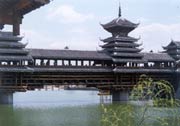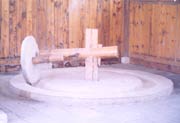| The Wind-and-Rain Bridge
 The Dong people usually build their villages across rivers; thus, there are various kinds of bridges in Dong villages, such as slate bridges, stone arch bridges, bamboo bridges, wind-and-rain Bridges, etc.. Among these bridges the wind-and-rain bridge is most characterized with their national features. The Dong people usually build their villages across rivers; thus, there are various kinds of bridges in Dong villages, such as slate bridges, stone arch bridges, bamboo bridges, wind-and-rain Bridges, etc.. Among these bridges the wind-and-rain bridge is most characterized with their national features.
A wind-and-rain Bridge is a wooden covered corridor bridge, with pavilions and benches. People can rest on the bridge sitting or lying. Since the bridge shields people from wind, rain and sunshine, it is called the wind-and-rain Bridge, or sometimes "the flower bridge". For large-sized wind-and-rain bridges, the piers are made of big bluestone, upon which, big logs are spliced together by tenons, in a reversed pyramid, as the girder of the bridge. Upon these logs is the covering of the girder. In this way the openings have got a larger width. On the piers are pavilions, to add to the beauty of the bridge and the weight on both ends of the beams, and to increase the stability of the bridge body. Pavilions mostly have five layers of eaves, with a quadrangular or hexagonal roof, which is a spire or a long ridge; both practical and of artistic value.
 In Dong areas there are lots of wind-and-rain bridges: over 50 just in Liping County, and more are distributed in the Sanjiang area. The most representative one is Chengyang Bridge, in Sanjiang, Guangxi Province. It was built in 1916: 76 meters long, 10.6 meters high and 3.4 meters wide; 5 piers and 4 openings; like a huge dragon across the Chengyang River; one of the four most famous bridges in China, and an important national cultural relic. Eight fir logs are laid closely on the piers in two layers, above which are five pavilions of different styles of roofs, built together to form the covered corridor bridge floor. The three pavilions in the middle are in a four-layer pagoda style, while the other two are in a five-layer long-ridge style. The five pavilions stand in a row, in a magnificent manner. On eaves of the corridor and the pavilions, lively and colorful images such as mountains, rivers, lakes, flowers, birds, beasts and fish, are painted. The interesting thing is the leverage used in the pavilion eaves, with beams sticking out widely; thus the eaves curl upwards, like a white crane spreading its wings wide, ready to fly up to the sky. In Dong areas there are lots of wind-and-rain bridges: over 50 just in Liping County, and more are distributed in the Sanjiang area. The most representative one is Chengyang Bridge, in Sanjiang, Guangxi Province. It was built in 1916: 76 meters long, 10.6 meters high and 3.4 meters wide; 5 piers and 4 openings; like a huge dragon across the Chengyang River; one of the four most famous bridges in China, and an important national cultural relic. Eight fir logs are laid closely on the piers in two layers, above which are five pavilions of different styles of roofs, built together to form the covered corridor bridge floor. The three pavilions in the middle are in a four-layer pagoda style, while the other two are in a five-layer long-ridge style. The five pavilions stand in a row, in a magnificent manner. On eaves of the corridor and the pavilions, lively and colorful images such as mountains, rivers, lakes, flowers, birds, beasts and fish, are painted. The interesting thing is the leverage used in the pavilion eaves, with beams sticking out widely; thus the eaves curl upwards, like a white crane spreading its wings wide, ready to fly up to the sky.
The Symbol of a Dong Village: the drum-tower <<
The Fragrant and Sweet Oil-tea >>
|